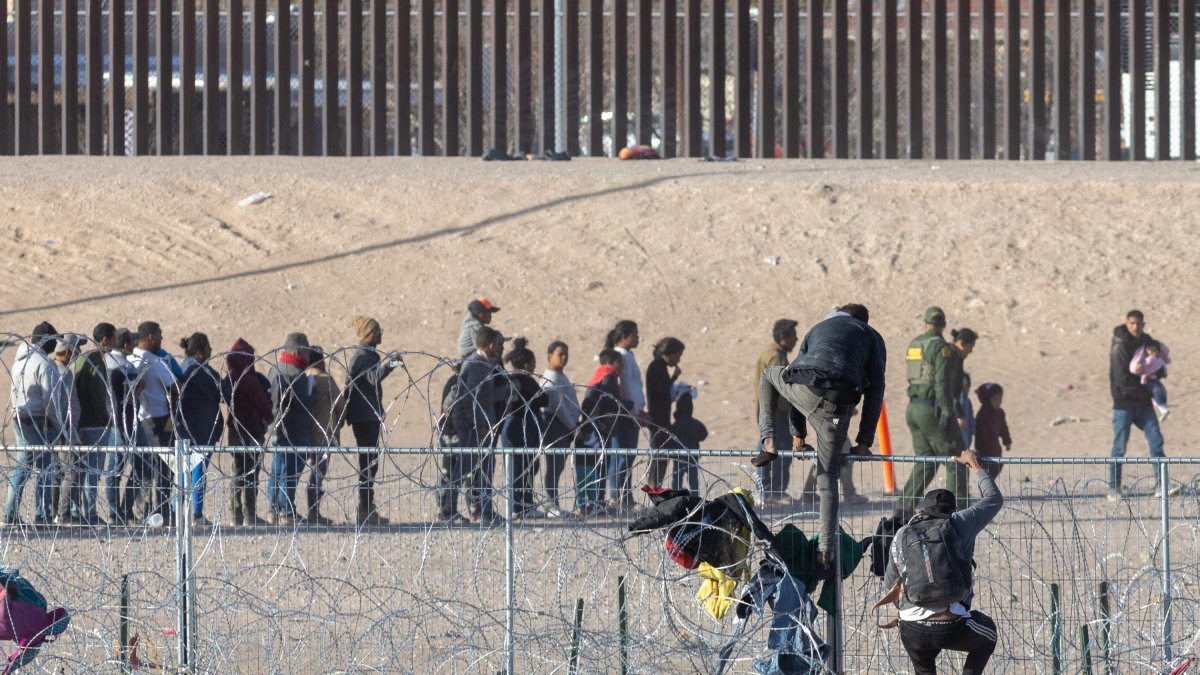The brutal fiscal impact of the border crisis: $1.15 trillion to taxpayers for new illegal immigrants
A detailed study by the Manhattan Institute showed how illegal immigration affects (and will continue to affect) the federal government. At the same time, a long-term solution is to promote legal, high-skilled immigration to reduce the enormous national debt.

Two men climb the cyclone fence installed by the Texas National Guard
The immigration crisis is not only causing a major humanitarian problem in border states and major cities receiving illegal immigrants, it is also generating, in the immediate present and distant future, a major waste of federal money that, measured in fiscal terms, will cost U.S. taxpayers approximately $1.15 trillion, according to a detailed study released this month by the Manhattan Institute.
The report cites the Congressional Budget Office, which estimates that the border surge will amount to 8.7 million illegal immigrants between 2021 and 2026, a relatively conservative figure considering that there are already reports that more than 10 million people crossed the U.S. border illegally during the Biden administration.
Considering the age and educational qualifications of immigrants, the report concludes that the border crisis will have an estimated fiscal cost to taxpayers of $1.15 trillion over the lifetime of the new illegal immigrants, that's greater than the U.S. Defense budget and nearly equal to the cost of Social Security in 2023.

Politics
White House resumes humanitarian parole for Cubans, Venezuelans, Nicaraguans and Haitians
Joaquín Núñez
Economist Daniel Di Martino, author of the study, explained to VOZ that the main long-term problem of uncontrolled immigration is that it will increase the nation's debt, which is already dangerously high, specifically at $34.7 trillion according to Department of Treasury figures.
"The most serious consequence of illegal immigration to the United States will be that the debt will increase substantially because of all the benefits that illegal immigrants will receive. And that's even without adding what Democratic-controlled states like New York and California provide on top of what they already receive or benefit from the federal government," the economist said, founder of the Dissident Project and a fellow at the Manhattan Institute.
"It is unfortunate that the federal government is allowing millions of people who will depend on the state to enter illegally and limiting both legal immigration of people who will contribute more in taxes than the benefits they enjoy."
However, Di Martino notes in his study that, just as illegal immigration is a short- and long-term problem, legal migration may be the solution to alleviating the national debt, becoming a long-term solution that could bring a positive fiscal impact to the country.

Sociedad
“Huge hoax": Republicans accuse Biden-Harris administration of covering up border crisis
Rosana Rábago Sainz
Illegal immigrants already have a minimal positive fiscal impact
Tellingly, the study notes that although a large number of illegal immigrants represent losses in the millions for the federal government, a portion represents a positive impact on taxpayers. These are young immigrants with college degrees.
Such is the positive fiscal impact of this type of immigrant that, by themselves, they can reduce the federal budget deficit by more than $10,000 over their lifetime.
"For comparison, the average native-born citizen is expected to cost over $250,000 to the federal government," the study added.
There is, however, a big problem in terms of illegal immigration. Although the average immigrant reduces the budget deficit, uneducated, elderly, and low-skilled immigrants are usually a major fiscal burden on the government. Some represent a net tax burden of up to $400,000, far more than a native-born citizen.
Moreover, the study published at the Manhattan Institute does not include, for example, the individualized expenditures by states that have suffered first-hand from the border crisis, making their resources steadily available for more than three years.
Still, the data demonstrates the great potential of academically prepared young immigrants.
"The large positive fiscal impact of young and college-educated immigrants pulls up the overall average. Each immigrant under the age of 35 with a graduate degree reduces the budget deficit by over $1 million in net present value during his lifetime," Di Martino writes in the report.

August 2023, Eagle Pass, Texas: a group of immigrants looks for an opening in the wire barrier
Which policy is the most beneficial to keep the border crisis from having a negative impact?
Now, with the general election just around the corner, which will define not only the person who will govern the country for four years but also the distribution of both Houses of Congress, many Americans will go to the polls thinking not only about inflation, security or the various problems the country has but also about the border crisis of the last three and a half years.
If they consider the border crisis an integral problem for the country, they may also consider the debt. In that sense, the two traditional political parties should be forced to find a bipartisan solution to correct the negative fiscal impact of illegal immigration.
The Manhattan Institute analyzed the general positive impact that the following policies would generate: mass deportations, selective deportations and selective legalizations.
While mass deportations would save the federal government a great deal of money, the cost of each deportation, considering all the resources that would be invested in tracking and removals, could range from $65,000 to $130,000 per immigrant. Based on the best-case scenario, the study shows that a mass deportation policy (ten million people) could save the government $1.3 billion.
In the worst-case scenario, with a deportation that exceeds $100,000 per immigrant by quite a bit, the positive fiscal impact would be only $664 billion.
The second policy, selective deportations, would include immigrants without a college education. The positive fiscal impact could be as much as $1.8 billion, considering that the cost of deportation would be $65,000.
According to the study, the positive fiscal impact would be $1.2 billion in the worst-case scenario.
However, selective legalization, which would also include deportations and, therefore, would be applying a mixed policy where legal migration is promoted and illegal migration is discouraged, would have a positive fiscal impact for the federal government of $1.9 trillion, considering that $1 trillion would come from the taxes of these immigrants and about $900,900 billion would come from net savings from deportations.
In the worst-case scenario, the positive impact would be about $1.6 trillion.
To promote legal immigration, the study proposes two policies: doubling H-1B visas and allowing graduates in science, technology, engineering and math (STEM) fields not to be subject to Green Card limitations.
"Given the education, age, and earnings of H-1B visa recipients, doubling the number of H-1B visas for just one year would reduce the budget deficit by $70 billion over the long run—and by another $70 billion each year thereafter," the report states.
H-1B visas are nonimmigrant visas in the United States, allowing domestic companies to temporarily hire highly skilled foreign workers in specialty occupations.
"The most beneficial immigration policy change would be to exempt STEM graduate degree holders from green-card caps, increasing immigration by some 15,000 people per year and reducing the visa backlog; this would reduce the deficit by $150 billion in the first year and $25 billion each year thereafter," the report concludes.













